Workbook: Prejudice and Discrimination - Social Sciences & Psychology
VerifiedAdded on 2020/05/28
|27
|8427
|550
Homework Assignment
AI Summary
This workbook, prepared by a student for the 'Individual in Society' module at Western Sydney University, delves into the complex topics of prejudice and discrimination. It begins by establishing a foundational understanding of attitudes, stereotypes, prejudice, and discrimination, prompting critical thinking through definitions and examples. The workbook then explores the role of false beliefs in fueling prejudice, referencing academic articles and current events to illustrate how 'fake news' and institutional racism contribute to societal biases. The core of the workbook focuses on various types of prejudice, including sexism, prejudice based on sexual orientation, discrimination based on skin color, and nationality, with specific examples and thought-provoking questions designed to challenge assumptions about normalcy. The assignment encourages students to engage with the material, prepare for tutorials, and critically analyze the multifaceted nature of prejudice and discrimination in contemporary society.

101557
The Individual in Society
Workbook
Topic3
Prejudice & Discrimination
Written &compiled by Dr Tim Griffin
Contributions by Fiona Webber
School of Social Sciences & Psychology
The Individual in Society
Workbook
Topic3
Prejudice & Discrimination
Written &compiled by Dr Tim Griffin
Contributions by Fiona Webber
School of Social Sciences & Psychology
Paraphrase This Document
Need a fresh take? Get an instant paraphrase of this document with our AI Paraphraser
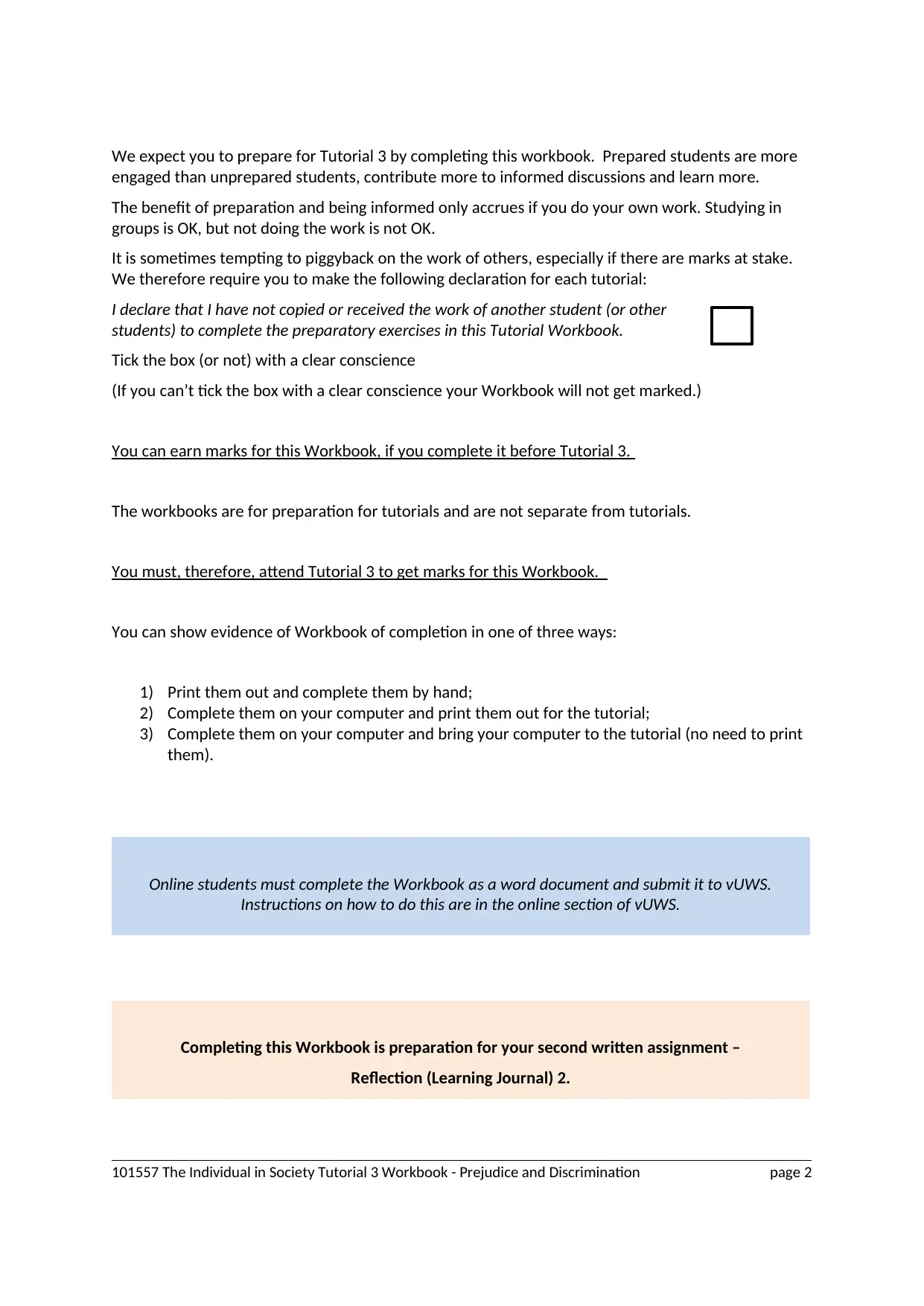
We expect you to prepare for Tutorial 3 by completing this workbook. Prepared students are more
engaged than unprepared students, contribute more to informed discussions and learn more.
The benefit of preparation and being informed only accrues if you do your own work. Studying in
groups is OK, but not doing the work is not OK.
It is sometimes tempting to piggyback on the work of others, especially if there are marks at stake.
We therefore require you to make the following declaration for each tutorial:
I declare that I have not copied or received the work of another student (or other
students) to complete the preparatory exercises in this Tutorial Workbook.
Tick the box (or not) with a clear conscience
(If you can’t tick the box with a clear conscience your Workbook will not get marked.)
You can earn marks for this Workbook, if you complete it before Tutorial 3.
The workbooks are for preparation for tutorials and are not separate from tutorials.
You must, therefore, attend Tutorial 3 to get marks for this Workbook.
You can show evidence of Workbook of completion in one of three ways:
1) Print them out and complete them by hand;
2) Complete them on your computer and print them out for the tutorial;
3) Complete them on your computer and bring your computer to the tutorial (no need to print
them).
101557 The Individual in Society Tutorial 3 Workbook - Prejudice and Discrimination page 2
Online students must complete the Workbook as a word document and submit it to vUWS.
Instructions on how to do this are in the online section of vUWS.
Completing this Workbook is preparation for your second written assignment –
Reflection (Learning Journal) 2.
engaged than unprepared students, contribute more to informed discussions and learn more.
The benefit of preparation and being informed only accrues if you do your own work. Studying in
groups is OK, but not doing the work is not OK.
It is sometimes tempting to piggyback on the work of others, especially if there are marks at stake.
We therefore require you to make the following declaration for each tutorial:
I declare that I have not copied or received the work of another student (or other
students) to complete the preparatory exercises in this Tutorial Workbook.
Tick the box (or not) with a clear conscience
(If you can’t tick the box with a clear conscience your Workbook will not get marked.)
You can earn marks for this Workbook, if you complete it before Tutorial 3.
The workbooks are for preparation for tutorials and are not separate from tutorials.
You must, therefore, attend Tutorial 3 to get marks for this Workbook.
You can show evidence of Workbook of completion in one of three ways:
1) Print them out and complete them by hand;
2) Complete them on your computer and print them out for the tutorial;
3) Complete them on your computer and bring your computer to the tutorial (no need to print
them).
101557 The Individual in Society Tutorial 3 Workbook - Prejudice and Discrimination page 2
Online students must complete the Workbook as a word document and submit it to vUWS.
Instructions on how to do this are in the online section of vUWS.
Completing this Workbook is preparation for your second written assignment –
Reflection (Learning Journal) 2.
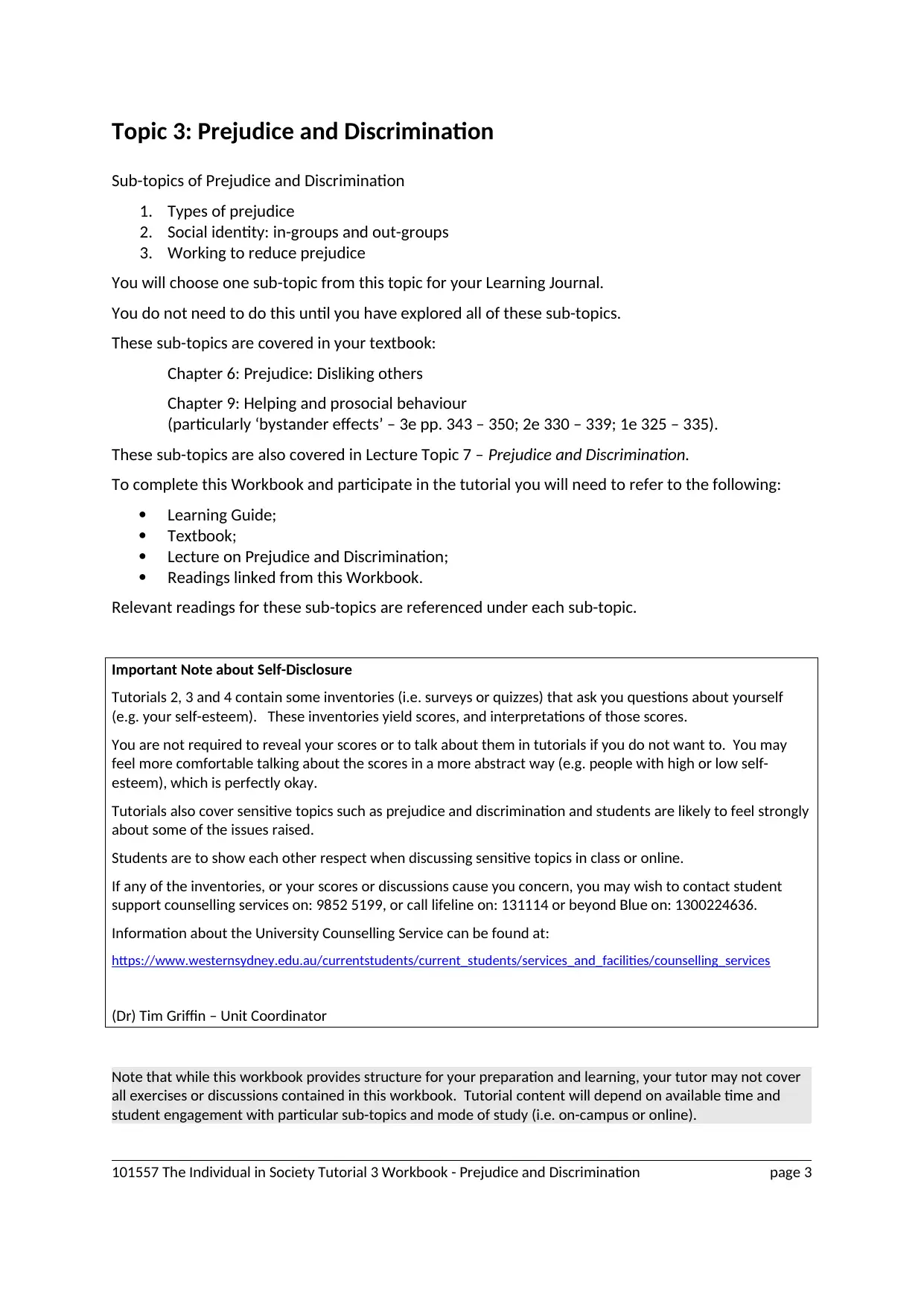
Topic 3: Prejudice and Discrimination
Sub-topics of Prejudice and Discrimination
1. Types of prejudice
2. Social identity: in-groups and out-groups
3. Working to reduce prejudice
You will choose one sub-topic from this topic for your Learning Journal.
You do not need to do this until you have explored all of these sub-topics.
These sub-topics are covered in your textbook:
Chapter 6: Prejudice: Disliking others
Chapter 9: Helping and prosocial behaviour
(particularly ‘bystander effects’ – 3e pp. 343 – 350; 2e 330 – 339; 1e 325 – 335).
These sub-topics are also covered in Lecture Topic 7 – Prejudice and Discrimination.
To complete this Workbook and participate in the tutorial you will need to refer to the following:
Learning Guide;
Textbook;
Lecture on Prejudice and Discrimination;
Readings linked from this Workbook.
Relevant readings for these sub-topics are referenced under each sub-topic.
Important Note about Self-Disclosure
Tutorials 2, 3 and 4 contain some inventories (i.e. surveys or quizzes) that ask you questions about yourself
(e.g. your self-esteem). These inventories yield scores, and interpretations of those scores.
You are not required to reveal your scores or to talk about them in tutorials if you do not want to. You may
feel more comfortable talking about the scores in a more abstract way (e.g. people with high or low self-
esteem), which is perfectly okay.
Tutorials also cover sensitive topics such as prejudice and discrimination and students are likely to feel strongly
about some of the issues raised.
Students are to show each other respect when discussing sensitive topics in class or online.
If any of the inventories, or your scores or discussions cause you concern, you may wish to contact student
support counselling services on: 9852 5199, or call lifeline on: 131114 or beyond Blue on: 1300224636.
Information about the University Counselling Service can be found at:
https://www.westernsydney.edu.au/currentstudents/current_students/services_and_facilities/counselling_services
(Dr) Tim Griffin – Unit Coordinator
Note that while this workbook provides structure for your preparation and learning, your tutor may not cover
all exercises or discussions contained in this workbook. Tutorial content will depend on available time and
student engagement with particular sub-topics and mode of study (i.e. on-campus or online).
101557 The Individual in Society Tutorial 3 Workbook - Prejudice and Discrimination page 3
Sub-topics of Prejudice and Discrimination
1. Types of prejudice
2. Social identity: in-groups and out-groups
3. Working to reduce prejudice
You will choose one sub-topic from this topic for your Learning Journal.
You do not need to do this until you have explored all of these sub-topics.
These sub-topics are covered in your textbook:
Chapter 6: Prejudice: Disliking others
Chapter 9: Helping and prosocial behaviour
(particularly ‘bystander effects’ – 3e pp. 343 – 350; 2e 330 – 339; 1e 325 – 335).
These sub-topics are also covered in Lecture Topic 7 – Prejudice and Discrimination.
To complete this Workbook and participate in the tutorial you will need to refer to the following:
Learning Guide;
Textbook;
Lecture on Prejudice and Discrimination;
Readings linked from this Workbook.
Relevant readings for these sub-topics are referenced under each sub-topic.
Important Note about Self-Disclosure
Tutorials 2, 3 and 4 contain some inventories (i.e. surveys or quizzes) that ask you questions about yourself
(e.g. your self-esteem). These inventories yield scores, and interpretations of those scores.
You are not required to reveal your scores or to talk about them in tutorials if you do not want to. You may
feel more comfortable talking about the scores in a more abstract way (e.g. people with high or low self-
esteem), which is perfectly okay.
Tutorials also cover sensitive topics such as prejudice and discrimination and students are likely to feel strongly
about some of the issues raised.
Students are to show each other respect when discussing sensitive topics in class or online.
If any of the inventories, or your scores or discussions cause you concern, you may wish to contact student
support counselling services on: 9852 5199, or call lifeline on: 131114 or beyond Blue on: 1300224636.
Information about the University Counselling Service can be found at:
https://www.westernsydney.edu.au/currentstudents/current_students/services_and_facilities/counselling_services
(Dr) Tim Griffin – Unit Coordinator
Note that while this workbook provides structure for your preparation and learning, your tutor may not cover
all exercises or discussions contained in this workbook. Tutorial content will depend on available time and
student engagement with particular sub-topics and mode of study (i.e. on-campus or online).
101557 The Individual in Society Tutorial 3 Workbook - Prejudice and Discrimination page 3
⊘ This is a preview!⊘
Do you want full access?
Subscribe today to unlock all pages.

Trusted by 1+ million students worldwide
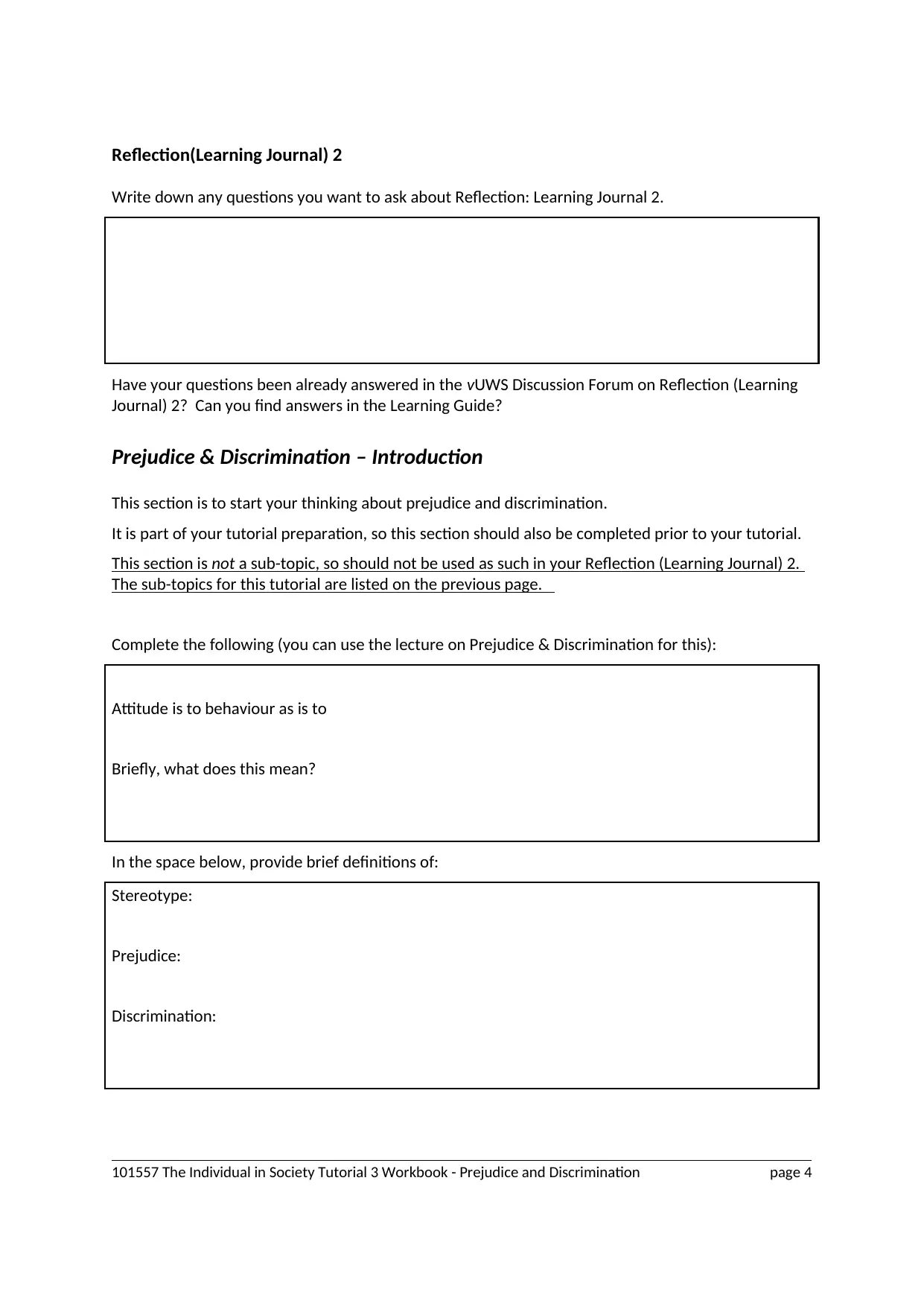
Reflection(Learning Journal) 2
Write down any questions you want to ask about Reflection: Learning Journal 2.
Have your questions been already answered in the vUWS Discussion Forum on Reflection (Learning
Journal) 2? Can you find answers in the Learning Guide?
Prejudice & Discrimination – Introduction
This section is to start your thinking about prejudice and discrimination.
It is part of your tutorial preparation, so this section should also be completed prior to your tutorial.
This section is not a sub-topic, so should not be used as such in your Reflection (Learning Journal) 2.
The sub-topics for this tutorial are listed on the previous page.
Complete the following (you can use the lecture on Prejudice & Discrimination for this):
Attitude is to behaviour as is to
Briefly, what does this mean?
In the space below, provide brief definitions of:
Stereotype:
Prejudice:
Discrimination:
101557 The Individual in Society Tutorial 3 Workbook - Prejudice and Discrimination page 4
Write down any questions you want to ask about Reflection: Learning Journal 2.
Have your questions been already answered in the vUWS Discussion Forum on Reflection (Learning
Journal) 2? Can you find answers in the Learning Guide?
Prejudice & Discrimination – Introduction
This section is to start your thinking about prejudice and discrimination.
It is part of your tutorial preparation, so this section should also be completed prior to your tutorial.
This section is not a sub-topic, so should not be used as such in your Reflection (Learning Journal) 2.
The sub-topics for this tutorial are listed on the previous page.
Complete the following (you can use the lecture on Prejudice & Discrimination for this):
Attitude is to behaviour as is to
Briefly, what does this mean?
In the space below, provide brief definitions of:
Stereotype:
Prejudice:
Discrimination:
101557 The Individual in Society Tutorial 3 Workbook - Prejudice and Discrimination page 4
Paraphrase This Document
Need a fresh take? Get an instant paraphrase of this document with our AI Paraphraser
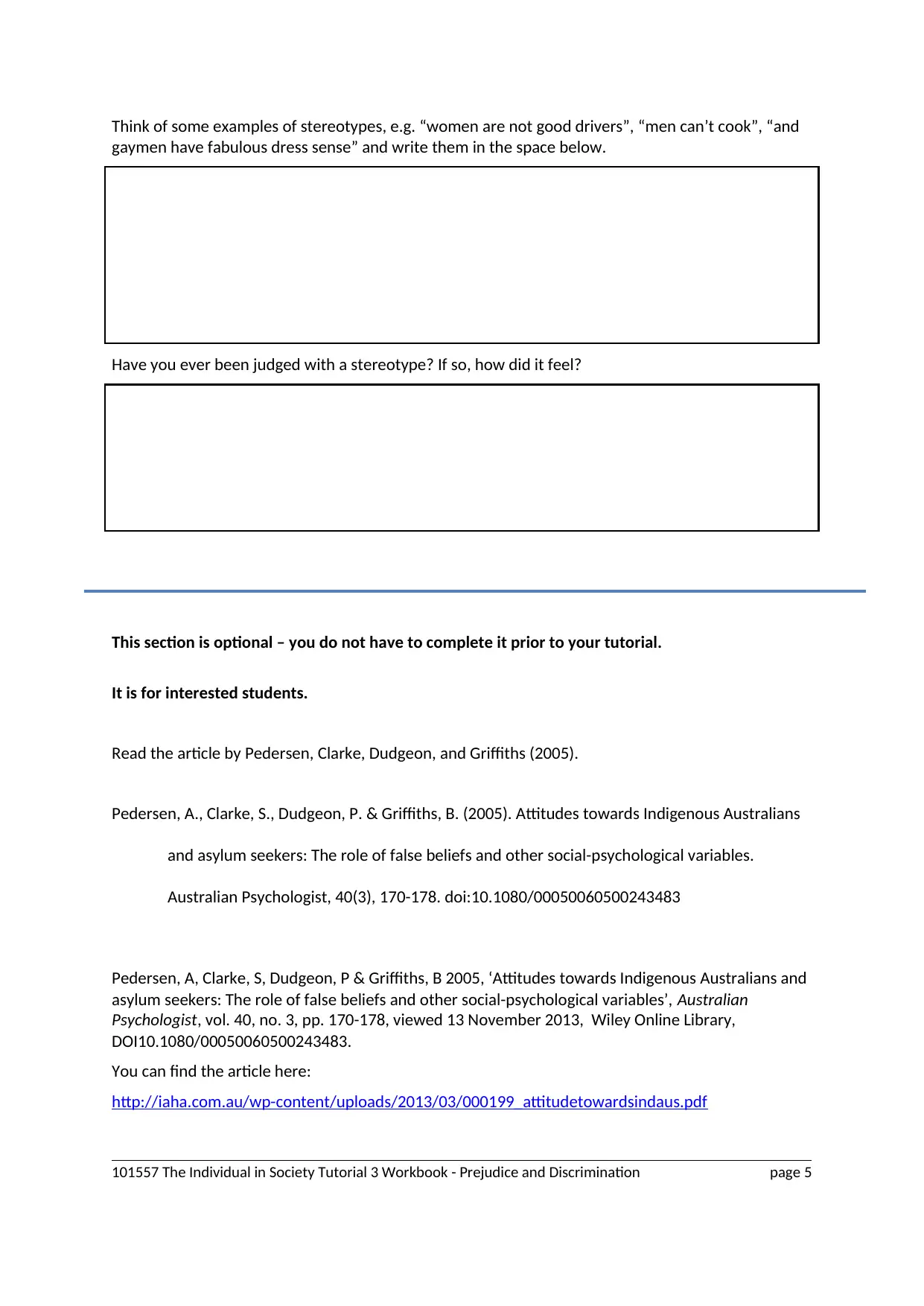
Think of some examples of stereotypes, e.g. “women are not good drivers”, “men can’t cook”, “and
gaymen have fabulous dress sense” and write them in the space below.
Have you ever been judged with a stereotype? If so, how did it feel?
This section is optional – you do not have to complete it prior to your tutorial.
It is for interested students.
Read the article by Pedersen, Clarke, Dudgeon, and Griffiths (2005).
Pedersen, A., Clarke, S., Dudgeon, P. & Griffiths, B. (2005). Attitudes towards Indigenous Australians
and asylum seekers: The role of false beliefs and other social-psychological variables.
Australian Psychologist, 40(3), 170-178. doi:10.1080/00050060500243483
Pedersen, A, Clarke, S, Dudgeon, P & Griffiths, B 2005, ‘Attitudes towards Indigenous Australians and
asylum seekers: The role of false beliefs and other social-psychological variables’, Australian
Psychologist, vol. 40, no. 3, pp. 170-178, viewed 13 November 2013, Wiley Online Library,
DOI10.1080/00050060500243483.
You can find the article here:
http://iaha.com.au/wp-content/uploads/2013/03/000199_attitudetowardsindaus.pdf
101557 The Individual in Society Tutorial 3 Workbook - Prejudice and Discrimination page 5
gaymen have fabulous dress sense” and write them in the space below.
Have you ever been judged with a stereotype? If so, how did it feel?
This section is optional – you do not have to complete it prior to your tutorial.
It is for interested students.
Read the article by Pedersen, Clarke, Dudgeon, and Griffiths (2005).
Pedersen, A., Clarke, S., Dudgeon, P. & Griffiths, B. (2005). Attitudes towards Indigenous Australians
and asylum seekers: The role of false beliefs and other social-psychological variables.
Australian Psychologist, 40(3), 170-178. doi:10.1080/00050060500243483
Pedersen, A, Clarke, S, Dudgeon, P & Griffiths, B 2005, ‘Attitudes towards Indigenous Australians and
asylum seekers: The role of false beliefs and other social-psychological variables’, Australian
Psychologist, vol. 40, no. 3, pp. 170-178, viewed 13 November 2013, Wiley Online Library,
DOI10.1080/00050060500243483.
You can find the article here:
http://iaha.com.au/wp-content/uploads/2013/03/000199_attitudetowardsindaus.pdf
101557 The Individual in Society Tutorial 3 Workbook - Prejudice and Discrimination page 5
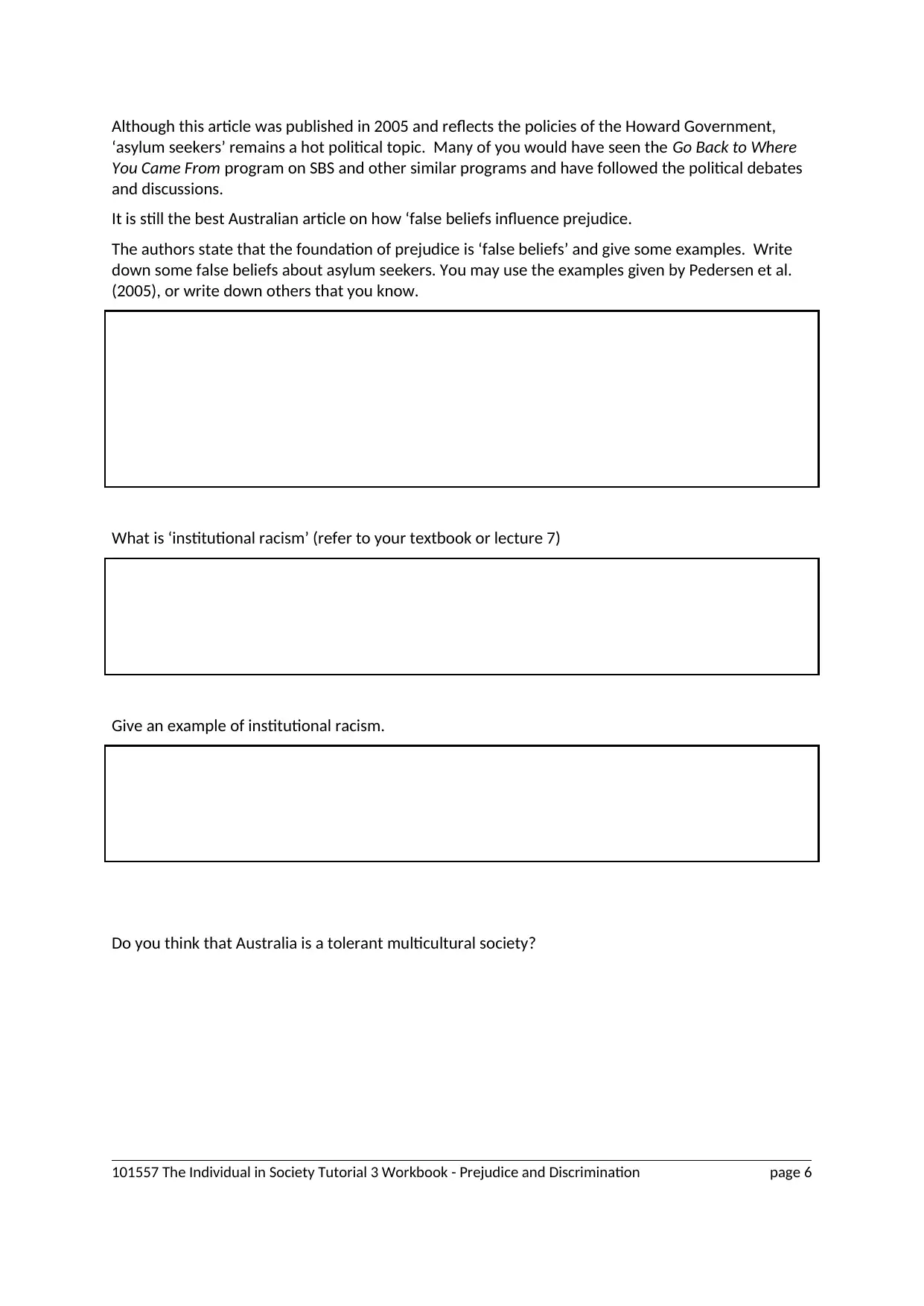
Although this article was published in 2005 and reflects the policies of the Howard Government,
‘asylum seekers’ remains a hot political topic. Many of you would have seen the Go Back to Where
You Came From program on SBS and other similar programs and have followed the political debates
and discussions.
It is still the best Australian article on how ‘false beliefs influence prejudice.
The authors state that the foundation of prejudice is ‘false beliefs’ and give some examples. Write
down some false beliefs about asylum seekers. You may use the examples given by Pedersen et al.
(2005), or write down others that you know.
What is ‘institutional racism’ (refer to your textbook or lecture 7)
Give an example of institutional racism.
Do you think that Australia is a tolerant multicultural society?
101557 The Individual in Society Tutorial 3 Workbook - Prejudice and Discrimination page 6
‘asylum seekers’ remains a hot political topic. Many of you would have seen the Go Back to Where
You Came From program on SBS and other similar programs and have followed the political debates
and discussions.
It is still the best Australian article on how ‘false beliefs influence prejudice.
The authors state that the foundation of prejudice is ‘false beliefs’ and give some examples. Write
down some false beliefs about asylum seekers. You may use the examples given by Pedersen et al.
(2005), or write down others that you know.
What is ‘institutional racism’ (refer to your textbook or lecture 7)
Give an example of institutional racism.
Do you think that Australia is a tolerant multicultural society?
101557 The Individual in Society Tutorial 3 Workbook - Prejudice and Discrimination page 6
⊘ This is a preview!⊘
Do you want full access?
Subscribe today to unlock all pages.

Trusted by 1+ million students worldwide
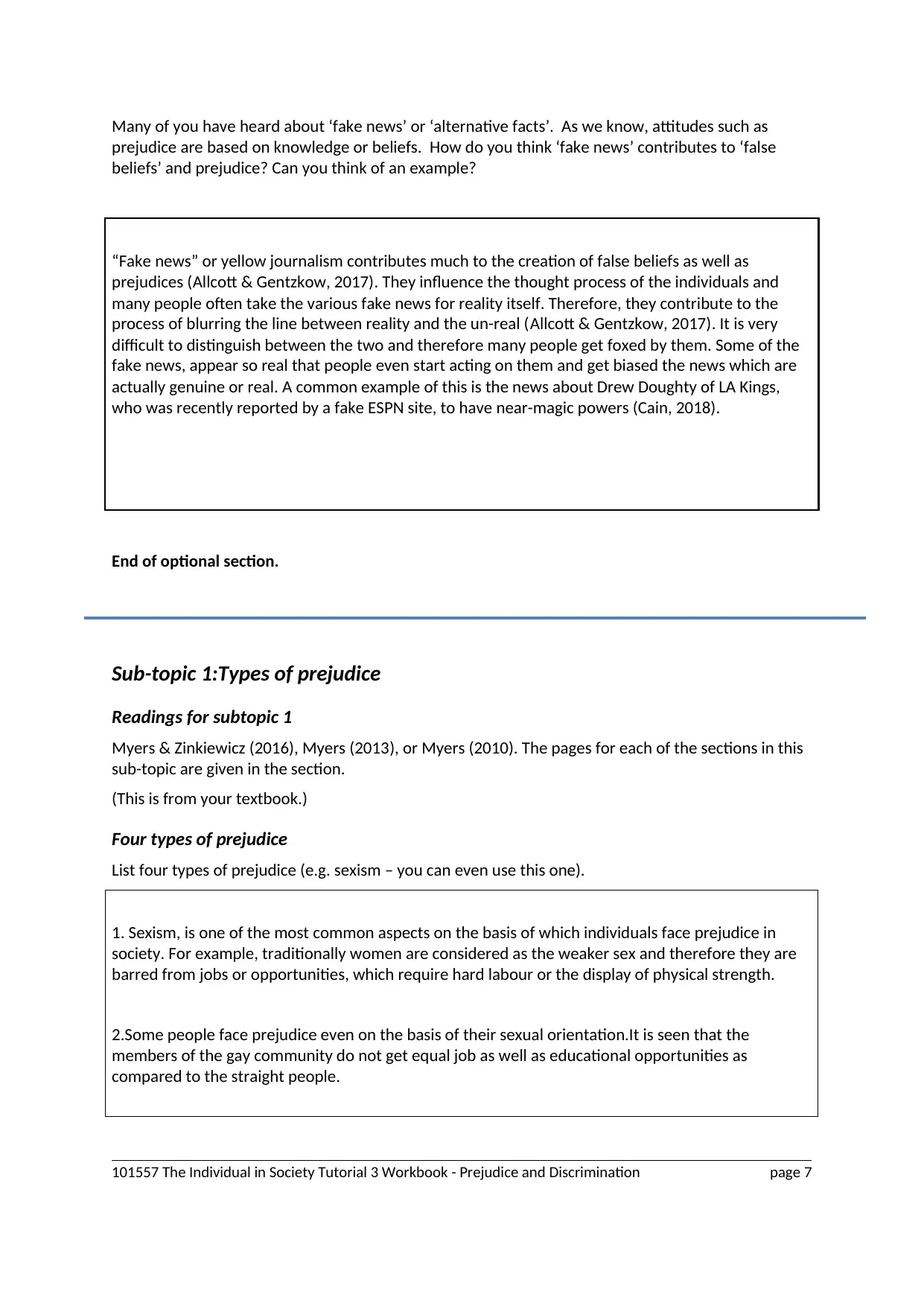
Many of you have heard about ‘fake news’ or ‘alternative facts’. As we know, attitudes such as
prejudice are based on knowledge or beliefs. How do you think ‘fake news’ contributes to ‘false
beliefs’ and prejudice? Can you think of an example?
“Fake news” or yellow journalism contributes much to the creation of false beliefs as well as
prejudices (Allcott & Gentzkow, 2017). They influence the thought process of the individuals and
many people often take the various fake news for reality itself. Therefore, they contribute to the
process of blurring the line between reality and the un-real (Allcott & Gentzkow, 2017). It is very
difficult to distinguish between the two and therefore many people get foxed by them. Some of the
fake news, appear so real that people even start acting on them and get biased the news which are
actually genuine or real. A common example of this is the news about Drew Doughty of LA Kings,
who was recently reported by a fake ESPN site, to have near-magic powers (Cain, 2018).
End of optional section.
Sub-topic 1:Types of prejudice
Readings for subtopic 1
Myers & Zinkiewicz (2016), Myers (2013), or Myers (2010). The pages for each of the sections in this
sub-topic are given in the section.
(This is from your textbook.)
Four types of prejudice
List four types of prejudice (e.g. sexism – you can even use this one).
1. Sexism, is one of the most common aspects on the basis of which individuals face prejudice in
society. For example, traditionally women are considered as the weaker sex and therefore they are
barred from jobs or opportunities, which require hard labour or the display of physical strength.
2.Some people face prejudice even on the basis of their sexual orientation.It is seen that the
members of the gay community do not get equal job as well as educational opportunities as
compared to the straight people.
101557 The Individual in Society Tutorial 3 Workbook - Prejudice and Discrimination page 7
prejudice are based on knowledge or beliefs. How do you think ‘fake news’ contributes to ‘false
beliefs’ and prejudice? Can you think of an example?
“Fake news” or yellow journalism contributes much to the creation of false beliefs as well as
prejudices (Allcott & Gentzkow, 2017). They influence the thought process of the individuals and
many people often take the various fake news for reality itself. Therefore, they contribute to the
process of blurring the line between reality and the un-real (Allcott & Gentzkow, 2017). It is very
difficult to distinguish between the two and therefore many people get foxed by them. Some of the
fake news, appear so real that people even start acting on them and get biased the news which are
actually genuine or real. A common example of this is the news about Drew Doughty of LA Kings,
who was recently reported by a fake ESPN site, to have near-magic powers (Cain, 2018).
End of optional section.
Sub-topic 1:Types of prejudice
Readings for subtopic 1
Myers & Zinkiewicz (2016), Myers (2013), or Myers (2010). The pages for each of the sections in this
sub-topic are given in the section.
(This is from your textbook.)
Four types of prejudice
List four types of prejudice (e.g. sexism – you can even use this one).
1. Sexism, is one of the most common aspects on the basis of which individuals face prejudice in
society. For example, traditionally women are considered as the weaker sex and therefore they are
barred from jobs or opportunities, which require hard labour or the display of physical strength.
2.Some people face prejudice even on the basis of their sexual orientation.It is seen that the
members of the gay community do not get equal job as well as educational opportunities as
compared to the straight people.
101557 The Individual in Society Tutorial 3 Workbook - Prejudice and Discrimination page 7
Paraphrase This Document
Need a fresh take? Get an instant paraphrase of this document with our AI Paraphraser
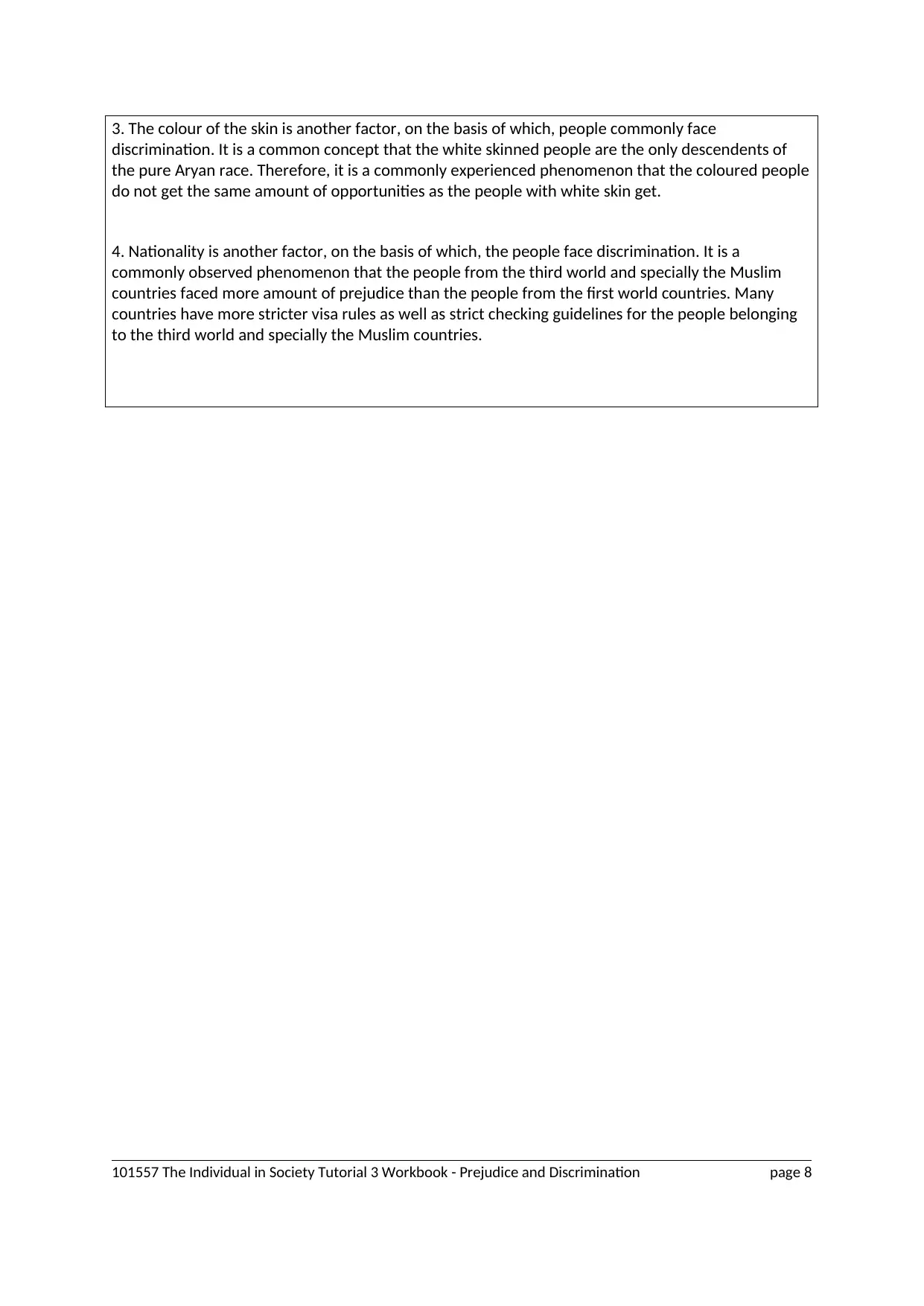
3. The colour of the skin is another factor, on the basis of which, people commonly face
discrimination. It is a common concept that the white skinned people are the only descendents of
the pure Aryan race. Therefore, it is a commonly experienced phenomenon that the coloured people
do not get the same amount of opportunities as the people with white skin get.
4. Nationality is another factor, on the basis of which, the people face discrimination. It is a
commonly observed phenomenon that the people from the third world and specially the Muslim
countries faced more amount of prejudice than the people from the first world countries. Many
countries have more stricter visa rules as well as strict checking guidelines for the people belonging
to the third world and specially the Muslim countries.
101557 The Individual in Society Tutorial 3 Workbook - Prejudice and Discrimination page 8
discrimination. It is a common concept that the white skinned people are the only descendents of
the pure Aryan race. Therefore, it is a commonly experienced phenomenon that the coloured people
do not get the same amount of opportunities as the people with white skin get.
4. Nationality is another factor, on the basis of which, the people face discrimination. It is a
commonly observed phenomenon that the people from the third world and specially the Muslim
countries faced more amount of prejudice than the people from the first world countries. Many
countries have more stricter visa rules as well as strict checking guidelines for the people belonging
to the third world and specially the Muslim countries.
101557 The Individual in Society Tutorial 3 Workbook - Prejudice and Discrimination page 8

Prejudice on the basis of sexual orientation
Read Myers & Zinkiewicz (2016, p. 192), Myers (2013, p. 180), or Myers (2010, pp. 174).
Your sexual orientation is none of our concern and you may decide to answer the questions below or
not. The point is that questions that might be asked (or thought) of gay, lesbian, transgender or
bisexual people to justify their sexual orientation are rarely asked of heterosexual people. These are
questions for heterosexual people, designed to raise awareness of the prejudices surrounding sexual
orientation.
1. What do you think caused your heterosexuality?
2. When and how did you first decide you were heterosexual?
3. Is it possible that your heterosexuality is just a phase you may grow out of?
4. Is it possible that your heterosexuality stems from a fear of others of the same sex?
5. If you have never slept with a member of your own sex, is it possible that you might be gay if
you tried it?
6. If heterosexuality is normal, why are so many mental patients heterosexual?
7. Why do you heterosexual people try to seduce others into your lifestyle?
8. Why do you flaunt your heterosexuality? Can't you just be who you are and keep it quiet?
9. The great majority of child molesters are heterosexual. Do you consider it safe to expose
your children to heterosexual teachers?
10. With all the societal support that marriage receives, the divorce rate is spiralling. Why are
there so few stable relationships among heterosexual people?
11. Why are heterosexual people so promiscuous?
12. Would you want your children to be heterosexual, knowing the problems they would face,
such as heartbreak, disease, and divorce?
You can find out more about this example at:
http://www.advocatesforyouth.org/index.php?option=com_content&task=view&id=222&Itemid=129
What do these questions tell you about prejudice on the basis of sexual orientation?
(You could think about social assumptions about what is ‘normal’.)
Normalcy is just a concept innovated by people to maintain the sexual power balance in the society.
William Shakespeare wrote in the sonnet number 144,”One’s angel is another’s hell”. Therefore, it
can be said that the concept of “normal” is too broad as well as stereotyped. People are often
categorised on the basis of their sexual preferences ("advocatesforyouth.org", 2018). However, it is
interesting to note that the heterosexual people upon the homosexuals as abnormal and vice versa.
Therefore, it can be safely concluded that the concept of normalcy is just a facade. The above
provided questions clearly indicate the prejudice faced by the people who dare to drift away from
the line of “normalcy” and the resultant stigma as well as lack of opportunities faced by them. It is to
be noted that in this world normalcy means living by the age-established rules like having a good
paying job, if you are a guy then you should prefer a girl and vice versa and various other things.
101557 The Individual in Society Tutorial 3 Workbook - Prejudice and Discrimination page 9
Read Myers & Zinkiewicz (2016, p. 192), Myers (2013, p. 180), or Myers (2010, pp. 174).
Your sexual orientation is none of our concern and you may decide to answer the questions below or
not. The point is that questions that might be asked (or thought) of gay, lesbian, transgender or
bisexual people to justify their sexual orientation are rarely asked of heterosexual people. These are
questions for heterosexual people, designed to raise awareness of the prejudices surrounding sexual
orientation.
1. What do you think caused your heterosexuality?
2. When and how did you first decide you were heterosexual?
3. Is it possible that your heterosexuality is just a phase you may grow out of?
4. Is it possible that your heterosexuality stems from a fear of others of the same sex?
5. If you have never slept with a member of your own sex, is it possible that you might be gay if
you tried it?
6. If heterosexuality is normal, why are so many mental patients heterosexual?
7. Why do you heterosexual people try to seduce others into your lifestyle?
8. Why do you flaunt your heterosexuality? Can't you just be who you are and keep it quiet?
9. The great majority of child molesters are heterosexual. Do you consider it safe to expose
your children to heterosexual teachers?
10. With all the societal support that marriage receives, the divorce rate is spiralling. Why are
there so few stable relationships among heterosexual people?
11. Why are heterosexual people so promiscuous?
12. Would you want your children to be heterosexual, knowing the problems they would face,
such as heartbreak, disease, and divorce?
You can find out more about this example at:
http://www.advocatesforyouth.org/index.php?option=com_content&task=view&id=222&Itemid=129
What do these questions tell you about prejudice on the basis of sexual orientation?
(You could think about social assumptions about what is ‘normal’.)
Normalcy is just a concept innovated by people to maintain the sexual power balance in the society.
William Shakespeare wrote in the sonnet number 144,”One’s angel is another’s hell”. Therefore, it
can be said that the concept of “normal” is too broad as well as stereotyped. People are often
categorised on the basis of their sexual preferences ("advocatesforyouth.org", 2018). However, it is
interesting to note that the heterosexual people upon the homosexuals as abnormal and vice versa.
Therefore, it can be safely concluded that the concept of normalcy is just a facade. The above
provided questions clearly indicate the prejudice faced by the people who dare to drift away from
the line of “normalcy” and the resultant stigma as well as lack of opportunities faced by them. It is to
be noted that in this world normalcy means living by the age-established rules like having a good
paying job, if you are a guy then you should prefer a girl and vice versa and various other things.
101557 The Individual in Society Tutorial 3 Workbook - Prejudice and Discrimination page 9
⊘ This is a preview!⊘
Do you want full access?
Subscribe today to unlock all pages.

Trusted by 1+ million students worldwide
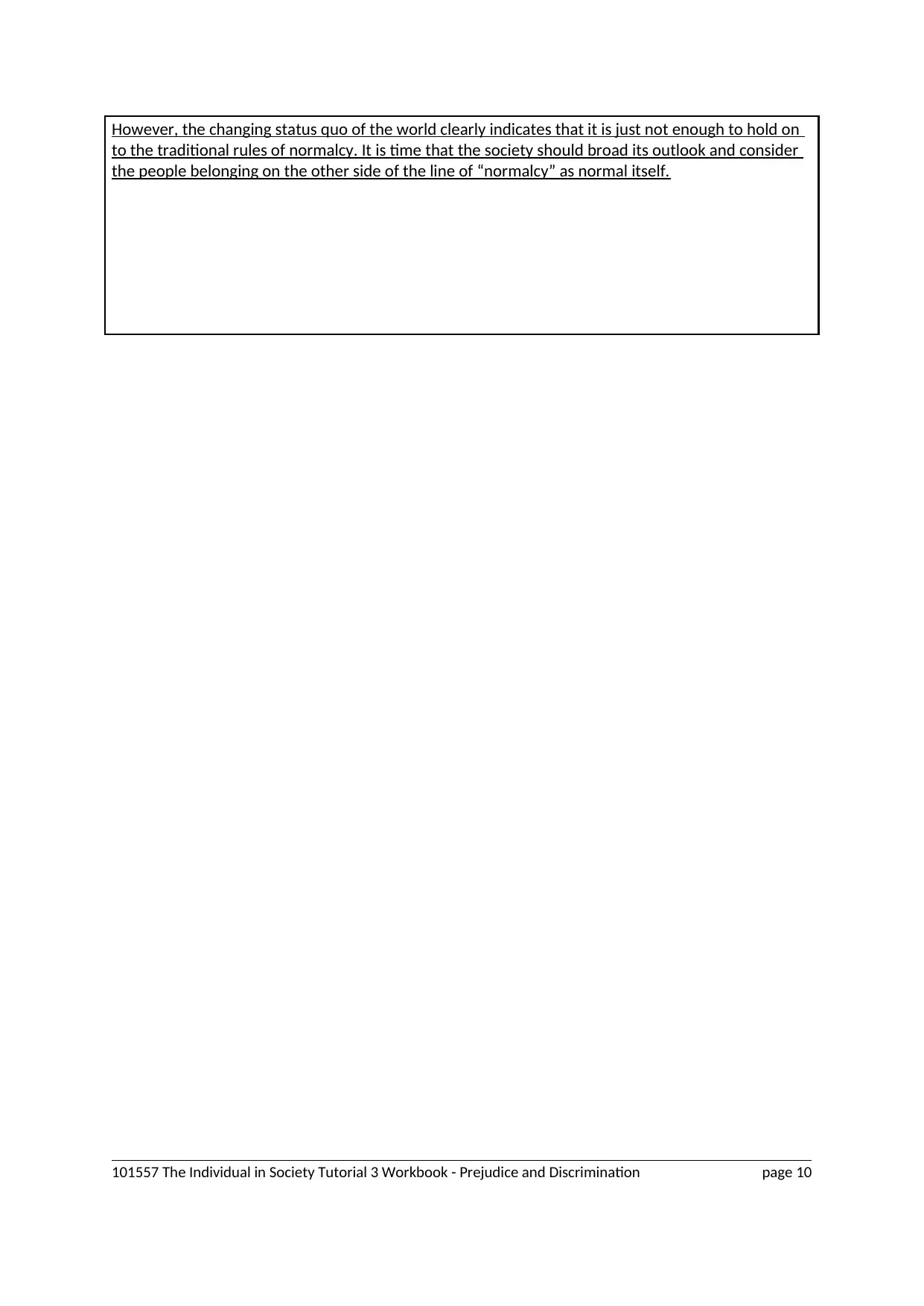
However, the changing status quo of the world clearly indicates that it is just not enough to hold on
to the traditional rules of normalcy. It is time that the society should broad its outlook and consider
the people belonging on the other side of the line of “normalcy” as normal itself.
101557 The Individual in Society Tutorial 3 Workbook - Prejudice and Discrimination page 10
to the traditional rules of normalcy. It is time that the society should broad its outlook and consider
the people belonging on the other side of the line of “normalcy” as normal itself.
101557 The Individual in Society Tutorial 3 Workbook - Prejudice and Discrimination page 10
Paraphrase This Document
Need a fresh take? Get an instant paraphrase of this document with our AI Paraphraser
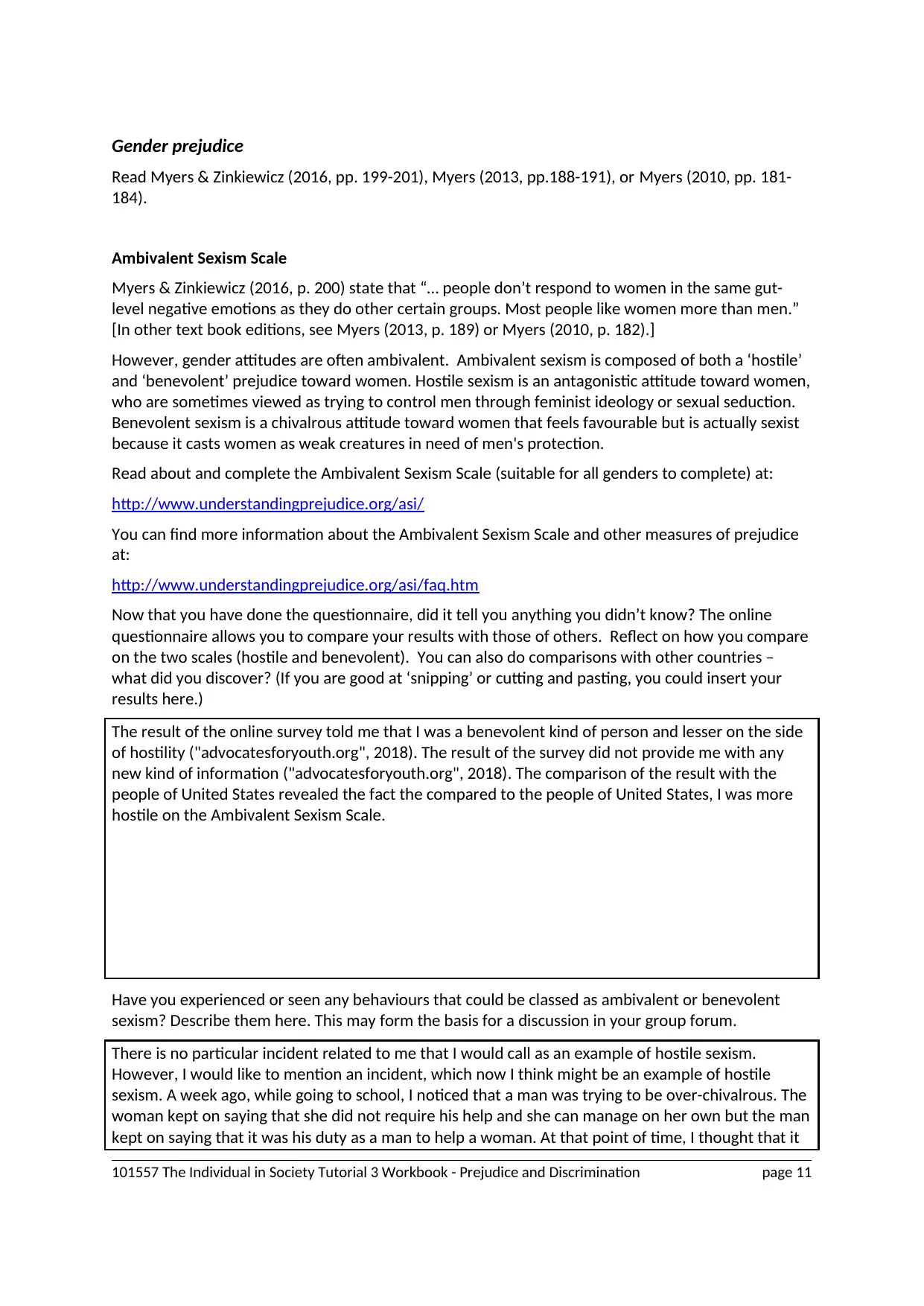
Gender prejudice
Read Myers & Zinkiewicz (2016, pp. 199-201), Myers (2013, pp.188-191), or Myers (2010, pp. 181-
184).
Ambivalent Sexism Scale
Myers & Zinkiewicz (2016, p. 200) state that “… people don’t respond to women in the same gut-
level negative emotions as they do other certain groups. Most people like women more than men.”
[In other text book editions, see Myers (2013, p. 189) or Myers (2010, p. 182).]
However, gender attitudes are often ambivalent. Ambivalent sexism is composed of both a ‘hostile’
and ‘benevolent’ prejudice toward women. Hostile sexism is an antagonistic attitude toward women,
who are sometimes viewed as trying to control men through feminist ideology or sexual seduction.
Benevolent sexism is a chivalrous attitude toward women that feels favourable but is actually sexist
because it casts women as weak creatures in need of men's protection.
Read about and complete the Ambivalent Sexism Scale (suitable for all genders to complete) at:
http://www.understandingprejudice.org/asi/
You can find more information about the Ambivalent Sexism Scale and other measures of prejudice
at:
http://www.understandingprejudice.org/asi/faq.htm
Now that you have done the questionnaire, did it tell you anything you didn’t know? The online
questionnaire allows you to compare your results with those of others. Reflect on how you compare
on the two scales (hostile and benevolent). You can also do comparisons with other countries –
what did you discover? (If you are good at ‘snipping’ or cutting and pasting, you could insert your
results here.)
The result of the online survey told me that I was a benevolent kind of person and lesser on the side
of hostility ("advocatesforyouth.org", 2018). The result of the survey did not provide me with any
new kind of information ("advocatesforyouth.org", 2018). The comparison of the result with the
people of United States revealed the fact the compared to the people of United States, I was more
hostile on the Ambivalent Sexism Scale.
Have you experienced or seen any behaviours that could be classed as ambivalent or benevolent
sexism? Describe them here. This may form the basis for a discussion in your group forum.
There is no particular incident related to me that I would call as an example of hostile sexism.
However, I would like to mention an incident, which now I think might be an example of hostile
sexism. A week ago, while going to school, I noticed that a man was trying to be over-chivalrous. The
woman kept on saying that she did not require his help and she can manage on her own but the man
kept on saying that it was his duty as a man to help a woman. At that point of time, I thought that it
101557 The Individual in Society Tutorial 3 Workbook - Prejudice and Discrimination page 11
Read Myers & Zinkiewicz (2016, pp. 199-201), Myers (2013, pp.188-191), or Myers (2010, pp. 181-
184).
Ambivalent Sexism Scale
Myers & Zinkiewicz (2016, p. 200) state that “… people don’t respond to women in the same gut-
level negative emotions as they do other certain groups. Most people like women more than men.”
[In other text book editions, see Myers (2013, p. 189) or Myers (2010, p. 182).]
However, gender attitudes are often ambivalent. Ambivalent sexism is composed of both a ‘hostile’
and ‘benevolent’ prejudice toward women. Hostile sexism is an antagonistic attitude toward women,
who are sometimes viewed as trying to control men through feminist ideology or sexual seduction.
Benevolent sexism is a chivalrous attitude toward women that feels favourable but is actually sexist
because it casts women as weak creatures in need of men's protection.
Read about and complete the Ambivalent Sexism Scale (suitable for all genders to complete) at:
http://www.understandingprejudice.org/asi/
You can find more information about the Ambivalent Sexism Scale and other measures of prejudice
at:
http://www.understandingprejudice.org/asi/faq.htm
Now that you have done the questionnaire, did it tell you anything you didn’t know? The online
questionnaire allows you to compare your results with those of others. Reflect on how you compare
on the two scales (hostile and benevolent). You can also do comparisons with other countries –
what did you discover? (If you are good at ‘snipping’ or cutting and pasting, you could insert your
results here.)
The result of the online survey told me that I was a benevolent kind of person and lesser on the side
of hostility ("advocatesforyouth.org", 2018). The result of the survey did not provide me with any
new kind of information ("advocatesforyouth.org", 2018). The comparison of the result with the
people of United States revealed the fact the compared to the people of United States, I was more
hostile on the Ambivalent Sexism Scale.
Have you experienced or seen any behaviours that could be classed as ambivalent or benevolent
sexism? Describe them here. This may form the basis for a discussion in your group forum.
There is no particular incident related to me that I would call as an example of hostile sexism.
However, I would like to mention an incident, which now I think might be an example of hostile
sexism. A week ago, while going to school, I noticed that a man was trying to be over-chivalrous. The
woman kept on saying that she did not require his help and she can manage on her own but the man
kept on saying that it was his duty as a man to help a woman. At that point of time, I thought that it
101557 The Individual in Society Tutorial 3 Workbook - Prejudice and Discrimination page 11

was completely natural, however, now when I look upon the incident in the light of the knowledge
about the concept of “hostile sexism”, I would say that the man by trying to help the woman was
just trying to assert his masculinity and suppress her femininity.
Sub-topic 2:Social Identity: In-groups and Out-groups
Readings for subtopic 2
Myers and Zinkiewicz (2016, pp. 209-217), Myers (2013, pp. 198-207) or Myers (2010, pp. 191-201);
Elder (2015)
To reference Elder (2015):
Harvard referencing style
Elder, J 2015, ‘United Patriots Front and No Room for Racism clash in central Melbourne’ The Age:
Victoria, November 28, viewed [insert the date you accessed the link here, e.g., 21 February 2016], <
http://www.theage.com.au/victoria/united-patriots-front-and-no-room-for-racism-clash-in-central-
melbourne-20151128-glaebb.html>.
APA referencing style
Elder, J. (2015, November 28). United Patriots Front and No Room for Racism clash in central
Melbourne. The Age: Victoria. Retrieved from http://www.theage.com.au/victoria/united-
patriots-front-and-no-room-for-racism-clash-in-central-melbourne-20151128-glaebb.html
Definitions
Provide definitions, using your own words as much as possible, for the terms below. Writing
definitions in your own words is practice in paraphrasing: an essential skill for university writing.
Social Identity “Social Identity”, can be defined, as the concept by means of which the
various entities within a particular group are able to identify themselves
within the group through their perceived notions of identity within the
group (Jenkins, 2014). In the words of Tajfel (1979), the concept of social
identity provides the members of the group with various important
features like notions of pride as well as self-esteem.
In-group
The concept of in-group in the genre of sociology as well as social
101557 The Individual in Society Tutorial 3 Workbook - Prejudice and Discrimination page 12
about the concept of “hostile sexism”, I would say that the man by trying to help the woman was
just trying to assert his masculinity and suppress her femininity.
Sub-topic 2:Social Identity: In-groups and Out-groups
Readings for subtopic 2
Myers and Zinkiewicz (2016, pp. 209-217), Myers (2013, pp. 198-207) or Myers (2010, pp. 191-201);
Elder (2015)
To reference Elder (2015):
Harvard referencing style
Elder, J 2015, ‘United Patriots Front and No Room for Racism clash in central Melbourne’ The Age:
Victoria, November 28, viewed [insert the date you accessed the link here, e.g., 21 February 2016], <
http://www.theage.com.au/victoria/united-patriots-front-and-no-room-for-racism-clash-in-central-
melbourne-20151128-glaebb.html>.
APA referencing style
Elder, J. (2015, November 28). United Patriots Front and No Room for Racism clash in central
Melbourne. The Age: Victoria. Retrieved from http://www.theage.com.au/victoria/united-
patriots-front-and-no-room-for-racism-clash-in-central-melbourne-20151128-glaebb.html
Definitions
Provide definitions, using your own words as much as possible, for the terms below. Writing
definitions in your own words is practice in paraphrasing: an essential skill for university writing.
Social Identity “Social Identity”, can be defined, as the concept by means of which the
various entities within a particular group are able to identify themselves
within the group through their perceived notions of identity within the
group (Jenkins, 2014). In the words of Tajfel (1979), the concept of social
identity provides the members of the group with various important
features like notions of pride as well as self-esteem.
In-group
The concept of in-group in the genre of sociology as well as social
101557 The Individual in Society Tutorial 3 Workbook - Prejudice and Discrimination page 12
⊘ This is a preview!⊘
Do you want full access?
Subscribe today to unlock all pages.

Trusted by 1+ million students worldwide
1 out of 27
Related Documents
Your All-in-One AI-Powered Toolkit for Academic Success.
+13062052269
info@desklib.com
Available 24*7 on WhatsApp / Email
![[object Object]](/_next/static/media/star-bottom.7253800d.svg)
Unlock your academic potential
Copyright © 2020–2025 A2Z Services. All Rights Reserved. Developed and managed by ZUCOL.




